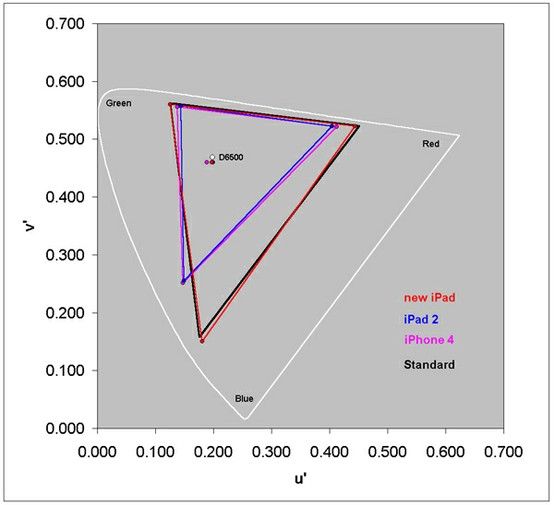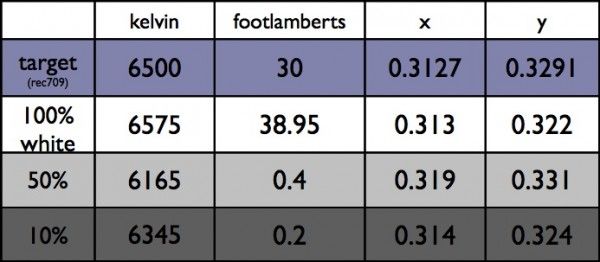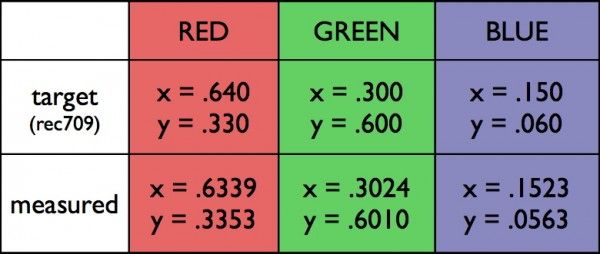
It allows to keep PV going, with more focus towards AI, but keeping be one of the few truly independent places.
-
Seriously, this thing is 99% close to the proper color gamut of rec709. (It's seems the white balance is a little cool, but nothing major.)
"...As Apple released the third generation iPad we saw two different reports suggesting that this new device had very accurate color – even describing it as being close to a professional broadcast monitor. That claim seemed like something we should check out so we loaded up an iPad 3 with normal test images and borrowed a Photo Research PR-650 SpectraScan Colorimeter to test it. Testing a $500 consumer device that has only a brightness control with a $12,000 Colorimeter – Hey why not?" Rest of article is here: http://www.fxphd.com/blog/just-how-good-is-the-ipads-color/
Also I've attached some color gamut comparisons from this article: http://www.negativespaces.com/blog/2012/3/27/new-ipads-color-gamut.html
Other useful articles: - http://michaelcioni.tumblr.com/post/19561057034/ipad-going-invisible - http://www.displaymate.com/iPad_ShootOut_1.htm
I know there is an ipad 3 thread, Vitaliy, so feel free to close this if you think it fits there. But I think it's maybe worth talking about and having people share their experiences of using the ipad 3 as a color reference device both on set and during color correction. So what do you think people?
It's true that we can't really use it as a "grading monitor" in the sense of connecting it to Davinci, BUT it provides a way to check any color grading you do on something that is basically as reliable as a broadcast monitor: you'll just have to take the extra steps of exporting a file (like h.264) for viewing on the iPad. Sure it's not perfect, but otherwise you'll have to spend over $2.5K to get a "professional" monitor.
The "measured" is the iPad 3.
-
As far as I remember, Ipad 4 has even better screen calibration. But this is all individual, as they have different manufacturers.
-
Huh, I didn't even know there was an iPad 4!!! ...just looked at one report that notes some slight improvement with iPad 4...
-
Any suggestions how to wire it for such a use?
-
Meaning?
For GH3 you could use Wi-Fi app, but I doubt that it is really best solution.
As for this screen, I am sure that quote soon we'll see camera monitors with Retina :-)
-
Actually, a friend of mine is developing a HDMI/HDSDI display based on Ipad Retina panel :)
-
-
I think that at a minimum you can output versions of what you are color grading to be viewed on an iPad. But there's also an app called Air Display, which I haven't used yet, that looks promising--although it's hooked up via Wifi which isn't so good...
@Vitaliy I just don't trust the color rendition on andriod tablets yet... even comparing my ipad 2 to an asus transformer prime showed the ipad to look much better. But that's just one example, and I'm definitely open to non-Apple high color gamut rec709 tablets / monitors from non-Apple firms.
-
I just don't trust the color rendition on andriod tablets yet... even comparing my ipad 2 to an asus transformer prime showed the ipad to look much better. But that's just one example, and I'm definitely open to non-Apple high color gamut rec709 tablets / monitors from non-Apple firms.
Android tablets is just too general term. As far as I know, Acer A700 has best color accurace from Full HD tablets.
As for your note - wide gamut and rec709 mean opposite things for good monitors. You can make tablet with very wide gamut screen (>100% NTSC), but manufacturers are not doing this as it means to make more narrow RGB filters, hence, reduced light output, and with same brightness you get smaller battery life or need to have bigger battery installed.
-
I know that wide gamut and rec709 are different, and I think I misleadingly suggested that "high color gamut" was the same as rec 709. The issue is obviously accuracy relative to the 709 gamut standard, which is quite restricted actually.
Do you references for the Acer A700 color accuracy? Color accurate relative to what standard? Rec 709, Adobe RGB, etc?
-
http://www.ixbt.com/portopc/acer-iconia-tab-a701.shtml, you can use google translate or just look at screen test charts.
-
From the link it still looks like new iPad has better screen relative to rec709; even reviewer says he/she personally prefers it. Also look at his/her ipad review: http://www.ixbt.com/td/new-ipad-test-display.shtml
Notice how the sRGB (rec 709) lines up better with the ipad than the asus. But I guess ipad is not "full HD" but Retina, so Asus might be best in terms of HD if you exclude Retina displays. In any case, the Asus also looks like a good option.
-
Just get notice that all this hold real meaning if you control enviroument :-)
This is why in good color grading books they spend so much on proper position, backgroud color behind monitor and lighting.
-
Yes... true. But hey, real environment control is much cheaper than professional monitor! ;-)
-
Just go and get any good large IPS based monitors (like discussed in our 27" topic). After this go and get monitor calibrator, run the wizard and it'll absolutely ok.
-
I remember this recommendation, and it makes sense IF your goal is to distribute only for the web or other computer monitors. But if you want to distribute to HDTVs or film festivals, then no computer monitor except the HP dreamcolor and one or two other expensive computer displays will get you to the proper color space. Otherwise you need a broadcast monitor or, hopefully as a cheap workaround a tablet that gets the rec709 space right.
Every professional color correction source I've researched confirms this, but I would be happy if they are wrong (though I doubt it).
-
if you want to distribute to HDTVs or film festivals, then no computer monitor except the HP dreamcolor and one or two other expensive computer displays will get you to the proper color space
This is incorrect. Yep, grading professionals like add mistery to their tools.
But anyone with even 32" IPS TV and proper calibration, proper grading place preparation will get almost same result as this guys.
Advantage of pro monitors are not color space only (it is just calibration at factory and must be made again after some period).
-
Well, if the cheaper monitor we are talking about is calibrated by bending the output LUT in the graphics card instead of uploading the correction into the monitor itself (with a decent bit depth LUT in there), we have one huge difference.
In most cases you are just transferring 8 bit to a non pro-grade monitor, and if you have to correct within these limited values, you can get banding. That's a very bad situation, since you can't judge anymore while grading if what you see is true banding or just the monitor…
-
On each case you need detailed research that calibration approach is better.
Yep, top NEC ot similar monitors could have 14 bit monitor LUT.
Modern AMD/NVidia use 10bit LUTs as I remember, with added dithering for 8bit output (dithering requires some extra steps on Windows, check Google).
Anyway, from my talks I did not heard big complains to severe banding after calibration.
-
Not as cheap as the iPad3 but cheaper then a broadcast monitor:
http://magazine.creativecow.net/article/matrox-mxo-broadcast-monitoring-on-a-desktop-monitor
-
@rikyxxx that is the original matrox which is (a) not sold anymore and (b) not compatible with Resolve (and probably other newer software).... it's not really an option anymore.
Also from that article: "the MXO doesn't yet work with the newer MacBook Pros. This is because Apple replaced the ATI graphics cards with Nvidia graphics cards, and the Nvidia cards on the laptops and MXO don't communicate well at the moment."
Believe me, I would LOVE if the original matrox was a viable solution... if others still use it with modern software like Resolve, I'd love to hear about it!
@Vitaliy_Kiselev ...I need to look into this more... I know that it's not just proper color space, but also gamma, rendition of blacks and white points (and more adjustability) that is an advantage of pro monitors.... are you saying you can get proper blacks and whites and gamma along with correct color space with regular IPS monitors like the Apple cinema display or the 27" IPS Korean Monitors with the right calibration? Using what?
-
@qwerty123 The article is old, and I already knew it, however it shows a solution that may be replicated with some work and competence, using newer tools.
Blackmagic has got a few playback devices and they're not expensive.
-
And what is the point to get external device that effectively do the same that video card LUT?
I know that it's not just proper color space, but also gamma, rendition of blacks and white points (and more adjustability) that is an advantage of pro monitors....
Adjustability is weird thing, as even cheap 2012 line LG TVs have 10 point adjustment (for gamme, and gray points), plus build in profiles for standard color spaces.
For normal monitor, you have IPS panel parameters (usually they are the same as in pro monitors, except high end pro models), in monitor adjustments and most of the time you'll be using video card LUT (with calibrator).
-
And what is the point to get external device that effectively do the same that video card LUT?
I may be wrong but I think devices like those have got specific LUT for the task and/or can let you "play" with and adjust their LUT.
-
LUT is defined by calibration app, so it is no different from graphic card. It is also have same 8 bit output, most probably dithered.
-
Hmm... after some searching it is surprisingly difficult to find a clear article or discussion of the differences between a calibrated (IPS) computer monitor and a professional color grading monitor.... ??? If you really can get pretty close with a calibrated IPS at home, and then have an important project, you can buy a small amount of time with a professional to do the final tweaks on what you did at home....
It does seem that in terms of computer monitors it's good to get something that's capable of being very close to sRGB....
I've read that this ASUS monitors is very good for that:
http://www.amazon.com/exec/obidos/ASIN/B005HIRG52/
I'm torn between that and another 27" IPS Korean monitor (which I really love)... is there any reports on sRGB fidelity for these monitors? I also want to use Resolve, and I need to see if I require a monitor with something other than DVI to be able to have a reference monitor feed from Resolve (via Intensity Pro card I guess). The Asus has hdmi which is one advantage.
I also realized that perhaps the Ipads eventually loose their calibration... and then you have no tools to recalibrate them! Hmmm...
Howdy, Stranger!
It looks like you're new here. If you want to get involved, click one of these buttons!
Categories
- Topics List23,911
- Blog5,718
- General and News1,330
- Hacks and Patches1,148
- ↳ Top Settings33
- ↳ Beginners254
- ↳ Archives402
- ↳ Hacks News and Development56
- Cameras2,342
- ↳ Panasonic984
- ↳ Canon118
- ↳ Sony154
- ↳ Nikon95
- ↳ Pentax and Samsung70
- ↳ Olympus and Fujifilm98
- ↳ Compacts and Camcorders295
- ↳ Smartphones for video96
- ↳ Pro Video Cameras191
- ↳ BlackMagic and other raw cameras116
- Skill1,959
- ↳ Business and distribution66
- ↳ Preparation, scripts and legal38
- ↳ Art149
- ↳ Import, Convert, Exporting291
- ↳ Editors190
- ↳ Effects and stunts115
- ↳ Color grading197
- ↳ Sound and Music280
- ↳ Lighting96
- ↳ Software and storage tips266
- Gear5,407
- ↳ Filters, Adapters, Matte boxes344
- ↳ Lenses1,577
- ↳ Follow focus and gears93
- ↳ Sound496
- ↳ Lighting gear313
- ↳ Camera movement230
- ↳ Gimbals and copters302
- ↳ Rigs and related stuff271
- ↳ Power solutions83
- ↳ Monitors and viewfinders339
- ↳ Tripods and fluid heads139
- ↳ Storage286
- ↳ Computers and studio gear559
- ↳ VR and 3D248
- Showcase1,859
- Marketplace2,834
- Offtopic1,314








